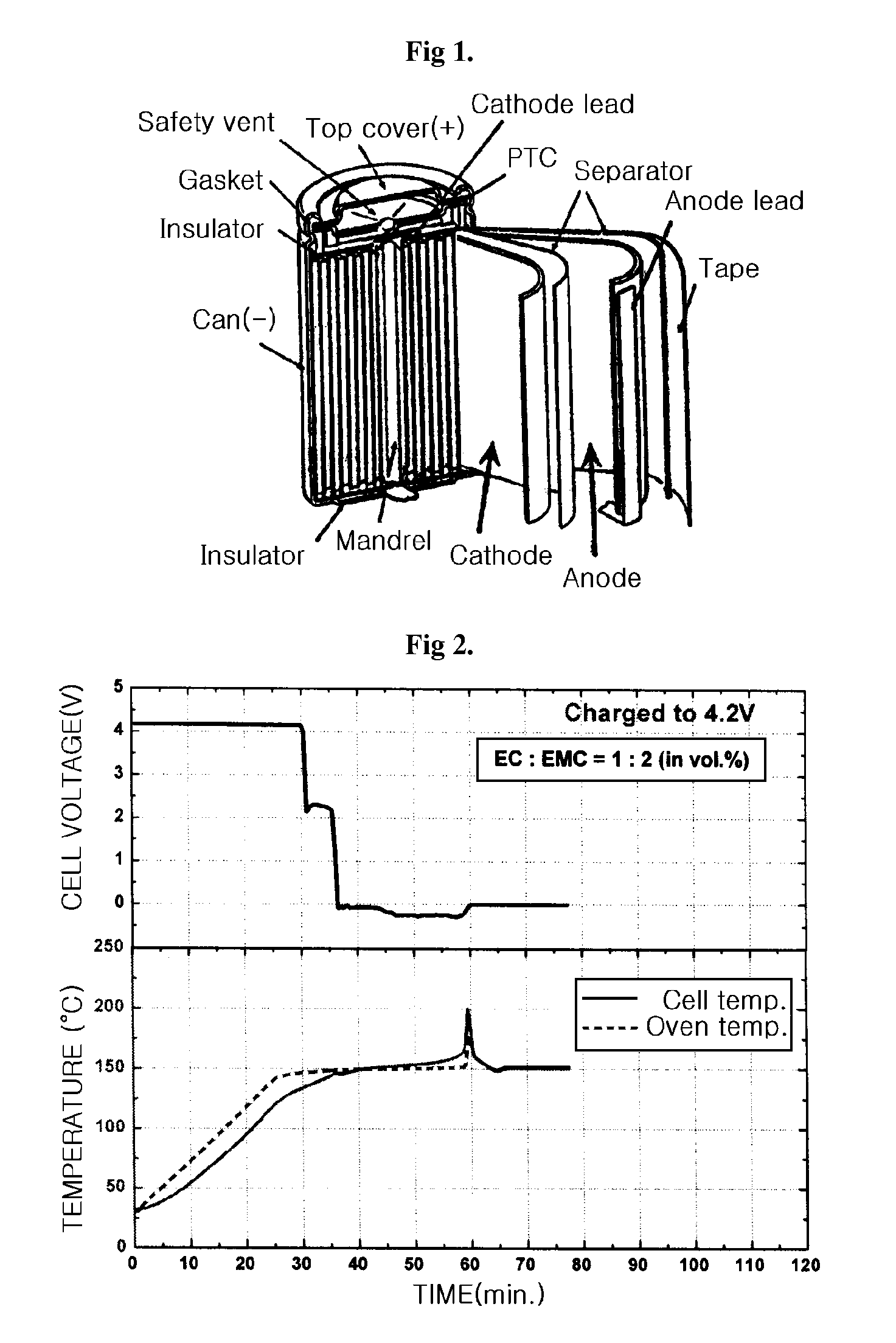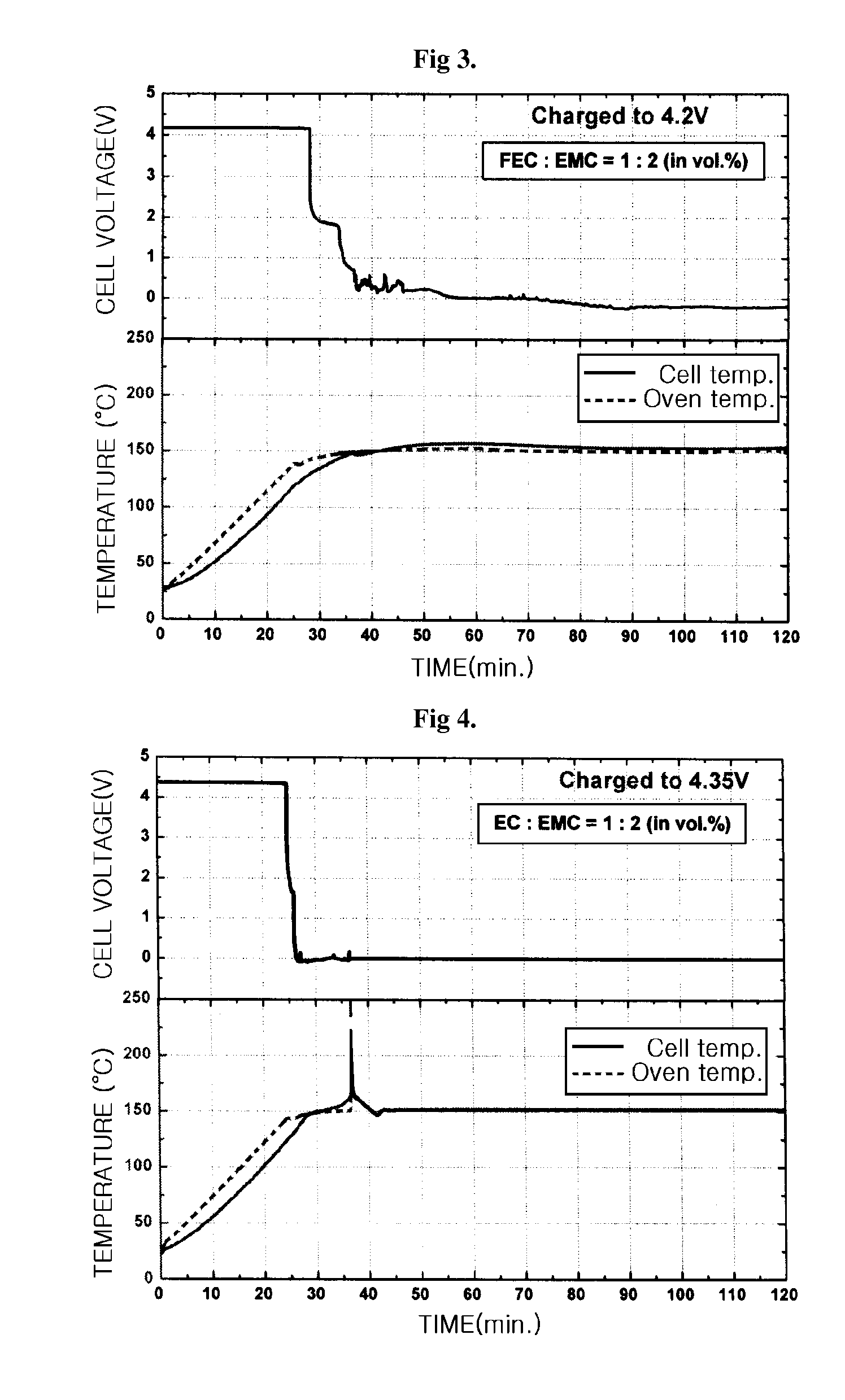Electrolyte for a high voltage battery and lithium secondary battery comprising the same
a high-voltage battery and lithium secondary battery technology, which is applied in the direction of electrolytes, non-aqueous electrolyte cells, cell components, etc., can solve the problems of deterioration in battery safety, large increase in electrolyte viscosity, combustion and explosion, etc., and achieve the effect of safe operation
Active Publication Date: 2013-02-05
LG ENERGY SOLUTION LTD
View PDF9 Cites 9 Cited by
- Summary
- Abstract
- Description
- Claims
- Application Information
AI Technical Summary
Benefits of technology
The present invention provides a safer electrolyte solvent for batteries that includes a fluoroethylene carbonate compound and a linear ester compound. The electrolyte solvent has improved stability and safety, and allows batteries to operate safely at a high voltage state without rapid exothermic reaction or substantial decomposition of the electrolyte. The technical effect of this invention is to increase the safety of batteries without compromising their performance.
Problems solved by technology
However, since increases in the battery capacity and in the operating voltage of batteries can lead to deterioration in the battery safety, various attempts to improve the safety of lithium secondary batteries have been made.
Such solvents are inflammable and thus, upon either an increase in temperature as caused by local short circuits within the batteries, or an increase in surrounding temperature, the solvents will easily react with oxygen generated by the structural degradation of an active material in the battery, particularly a positive active material, resulting in combustion and explosion.
Also, such flame retardant solvents show a lower solubility toward lithium salts than the existing cyclic carbonates and contain fluorine or phosphorus having a higher atomic weight than that of hydrogen in the unsubstituted cyclic carbonates, resulting in a great increase in the viscosity of electrolytes.
Thus, if the volume ratio of this flame retardant solvent in electrolyte solvent increases, the performance of batteries will greatly deteriorate due to a reduction in lithium ion conductivity.
Thus, if trifluoropropylene carbonate is used at the amount described in the Japanese publication, it will result in a significant reduction in the ion conductivity of the electrolyte formed therewith, thus making the deterioration of battery performance inevitable.
Moreover, as the trifluoropropylene carbonate is a propylene carbonate substituted with fluorine, it has some of the general disadvantages of propylene carbonate.
In particular, if it is used in an electrolyte solvent, the stability of any coating layer formed at the interface between a graphite negative electrode and an electrolyte will be adversely affected and therefore insufficient to a degree, and problems in the charge / discharge life cycles of the battery will occur, as described in Electrochimica Acta Vol. 45, p.
However, if the solvent of this composition is used as electrolyte solvent, the ion conductivity of electrolyte will be reduced to less than 7 mS / cm, thus deteriorating the performance of batteries, because fluoroethylene carbonate and propylene carbonate have high dielectric constant but undesirably high viscosity.
When the ion conductivity of electrolyte is reduced to less than 7 mS / cm, the conducting properties of the ions in the electrolyte deteriorate and the movement of the lithium ions becomes slow, resulting in an overall deterioration of the battery performance.
Method used
the structure of the environmentally friendly knitted fabric provided by the present invention; figure 2 Flow chart of the yarn wrapping machine for environmentally friendly knitted fabrics and storage devices; image 3 Is the parameter map of the yarn covering machine
View moreImage
Smart Image Click on the blue labels to locate them in the text.
Smart ImageViewing Examples
Examples
Experimental program
Comparison scheme
Effect test
examples 7 to 11
[0051]The preparation of electrolytes and the measurement of ion conductivity were performed in the same manner as in Examples 1-5 except that dimethyl carbonate (DMC) was used in place of ethyl methyl carbonate, at volume ratios given in Table 2.
the structure of the environmentally friendly knitted fabric provided by the present invention; figure 2 Flow chart of the yarn wrapping machine for environmentally friendly knitted fabrics and storage devices; image 3 Is the parameter map of the yarn covering machine
Login to View More PUM
| Property | Measurement | Unit |
|---|---|---|
| charging voltage | aaaaa | aaaaa |
| ion conductivity | aaaaa | aaaaa |
| full-charging voltage | aaaaa | aaaaa |
Login to View More
Abstract
The present invention provides an electrolyte for lithium secondary batteries that allows the batteries to operate safely at a charging voltage up to 4.35V, wherein the electrolyte comprises a combination of a fluoroethylene carbonate compound and a linear ester compound as solvent. Also, the present invention provides a lithium secondary battery that can operate at a charging voltage up to 4.35V, which comprises a positive electrode, a negative electrode and an electrolyte, wherein the electrolyte comprises fluoroethylene carbonate compound and linear ester compound as solvent.
Description
CROSS REFERENCE TO RELATED APPLICATION[0001]This application is a continuation-in-part of U.S. patent application Ser. No. 10 / 935,027, filed Sep. 7, 2004, which claims priority to Korean Patent Application No. 10-2003-0062206, filed on Sep. 5, 2003, and all the benefits accruing therefrom under 35 U.S.C. §119, the disclosure of which is incorporated by reference herein in its entirety.BACKGROUND OF THE INVENTION[0002]1. Technical Field[0003]The present invention relates to an electrolyte, which has improved safety and stability, for use in high voltage batteries, and to a lithium secondary battery comprising the electrolyte. Particularly, the present invention relates to an electrolyte that can operate safely when charged at a charging voltage of up to 4.35V or higher, and to a lithium secondary battery comprising the electrolyte.[0004]2. Background Art[0005]As the use of portable devices, such as high-performance notebook computers and mobile phones becomes increasingly popular all...
Claims
the structure of the environmentally friendly knitted fabric provided by the present invention; figure 2 Flow chart of the yarn wrapping machine for environmentally friendly knitted fabrics and storage devices; image 3 Is the parameter map of the yarn covering machine
Login to View More Application Information
Patent Timeline
 Login to View More
Login to View More Patent Type & Authority Patents(United States)
IPC IPC(8): H01M6/16
CPCH01M6/164H01M10/0525H01M10/0567H01M10/0569H01M2300/0034H01M2300/0037Y02E60/122Y02E60/10
Inventor IM, KEUN YUNGLEE, KI YOUNGBAE, JOON SUNGAN, YOUNG TACK
Owner LG ENERGY SOLUTION LTD
Features
- R&D
- Intellectual Property
- Life Sciences
- Materials
- Tech Scout
Why Patsnap Eureka
- Unparalleled Data Quality
- Higher Quality Content
- 60% Fewer Hallucinations
Social media
Patsnap Eureka Blog
Learn More Browse by: Latest US Patents, China's latest patents, Technical Efficacy Thesaurus, Application Domain, Technology Topic, Popular Technical Reports.
© 2025 PatSnap. All rights reserved.Legal|Privacy policy|Modern Slavery Act Transparency Statement|Sitemap|About US| Contact US: help@patsnap.com



